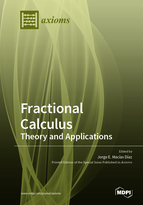Fractional Calculus - Theory and Applications
A special issue of Axioms (ISSN 2075-1680). This special issue belongs to the section "Mathematical Analysis".
Deadline for manuscript submissions: closed (31 August 2021) | Viewed by 26098
Special Issue Editor
2. Department of Mathematics and Physics, Autonomous University of Aguascalientes, Aguascalientes 20131, Mexico
Interests: fractional calculus; difference equations; differential equations
Special Issues, Collections and Topics in MDPI journals
Special Issue Information
Dear Colleagues,
In recent years, fractional calculus has witnessed tremendous progress in various areas of sciences and mathematics. On one hand, new definitions of fractional derivatives and integrals have appeared in recent years, extending the classical definitions in some sense or another. Moreover, the rigorous analysis of the functional properties of those new definitions has been an active area of research in mathematical analysis. Systems considering differential equations with fractional-order operators have been investigated rigorously from the analytical and numerical points of view, and potential applications have been proposed in the sciences and in technology. The purpose of this Special Issue is to serve as a specialized forum for the dissemination of recent progresses in the theory of fractional calculus and its potential applications. We invite authors to submit high-quality reports on the analysis of fractional-order differential/integral equations, the analysis of new definitions of fractional derivatives, numerical methods for fractional-order equations, and applications to physical systems governed by fractional differential equations, among other interesting topics of research.
Prof. Dr. Jorge E. Macías-Díaz
Guest Editor
Manuscript Submission Information
Manuscripts should be submitted online at www.mdpi.com by registering and logging in to this website. Once you are registered, click here to go to the submission form. Manuscripts can be submitted until the deadline. All submissions that pass pre-check are peer-reviewed. Accepted papers will be published continuously in the journal (as soon as accepted) and will be listed together on the special issue website. Research articles, review articles as well as short communications are invited. For planned papers, a title and short abstract (about 100 words) can be sent to the Editorial Office for announcement on this website.
Submitted manuscripts should not have been published previously, nor be under consideration for publication elsewhere (except conference proceedings papers). All manuscripts are thoroughly refereed through a single-blind peer-review process. A guide for authors and other relevant information for submission of manuscripts is available on the Instructions for Authors page. Axioms is an international peer-reviewed open access monthly journal published by MDPI.
Please visit the Instructions for Authors page before submitting a manuscript. The Article Processing Charge (APC) for publication in this open access journal is 2400 CHF (Swiss Francs). Submitted papers should be well formatted and use good English. Authors may use MDPI's English editing service prior to publication or during author revisions.
Keywords
- Fractional-order differential/integral equations
- Existence and regularity of solutions
- Numerical methods for fractional equations
- Analysis of convergence and stability
- Applications to science and technology
Benefits of Publishing in a Special Issue
- Ease of navigation: Grouping papers by topic helps scholars navigate broad scope journals more efficiently.
- Greater discoverability: Special Issues support the reach and impact of scientific research. Articles in Special Issues are more discoverable and cited more frequently.
- Expansion of research network: Special Issues facilitate connections among authors, fostering scientific collaborations.
- External promotion: Articles in Special Issues are often promoted through the journal's social media, increasing their visibility.
- e-Book format: Special Issues with more than 10 articles can be published as dedicated e-books, ensuring wide and rapid dissemination.
Further information on MDPI's Special Issue polices can be found here.





